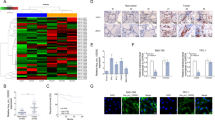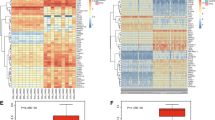Abstract
Background
Thyroid carcinoma (THCA) is the most prevalent tumor in the endocrine system with an increasing incidence. Recent studies have underscored the function of microRNAs (miRNAs) in THCA. Nevertheless, knowledge regarding the effects of exosomal miRNAs in THCA is still limited. This report intended to probe the regulatory effects of exosomal miR-152 on THCA and the underlying mechanism.
Methods
The expression profile of miR-152 was studied in clinical samples as well as B-CPAP and TPC-1 cells. Transwell, CCK-8, and flow cytometric assays were performed to investigate the roles of miR-152 on invasion, migration, proliferation, and apoptosis in B-CPAP and TPC-1 cells. The putative target of miR-152 was predicted using the bioinformatic analysis, and the targeting relationship was confirmed verified subsequently. Afterward, exosomes were isolated from bone marrow mesenchymal stem cells (BM-MSCs) and co-cultured with B-CPAP and TPC-1 cells to explore the function of exosomal miR-152 on THCA cells.
Results
miR-152 was reduced in THCA tissues and cells. Restoration of miR-152 inhibited proliferation, invasion and migration of B-CPAP and TPC-1 cells, but promoted cell apoptosis. Dipeptidyl dipeptidase 4 (DPP4), a target of miR-152, was found to promote THCA cell invasion and migration. miR-152 ferried by BM-MSCs-derived exosomes repressed THCA cell invasion and migration, and pcDNA-DPP4 weakened the repression effect.
Conclusion
Exosomal miR-152 inhibited proliferation, migration and invasion of THCA cells by binding with DPP4, which may represent a novel target for the treatment of THCA.






Similar content being viewed by others
References
Nguyen QT, Lee EJ, Huang MG, Park YI, Khullar A, Plodkowski RA (2015) Diagnosis and treatment of patients with thyroid cancer. Am Health Drug Benefits 8(1):30–40
Siegel RL, Miller KD, Jemal A (2020) Cancer statistics, 2020. CA Cancer J Clin 70(1):7–30. https://doi.org/10.3322/caac.21590
Carling T, Udelsman R (2014) Thyroid cancer. Annu Rev Med 65:125–137. https://doi.org/10.1146/annurev-med-061512-105739
Wei WJ, Zhang GQ, Luo QY (2018) Postsurgical management of differentiated thyroid cancer in China. Trends Endocrinol Metab 29(2):71–73. https://doi.org/10.1016/j.tem.2017.10.008
Squillaro T, Peluso G, Galderisi U (2016) Clinical trials with mesenchymal stem cells: an update. Cell Transplant 25(5):829–848. https://doi.org/10.3727/096368915X689622
Gyorgy B, Szabo TG, Pasztoi M, Pal Z, Misjak P, Aradi B, Laszlo V, Pallinger E, Pap E, Kittel A, Nagy G, Falus A, Buzas EI (2011) Membrane vesicles, current state-of-the-art: emerging role of extracellular vesicles. Cell Mol Life Sci 68(16):2667–2688. https://doi.org/10.1007/s00018-011-0689-3
Rappa G, Puglisi C, Santos MF, Forte S, Memeo L, Lorico A (2019) Extracellular vesicles from thyroid carcinoma: the new frontier of liquid biopsy. Int J Mol Sci. https://doi.org/10.3390/ijms20051114
Jiang K, Li G, Chen W, Song L, Wei T, Li Z, Gong R, Lei J, Shi H, Zhu J (2020) Plasma exosomal miR-146b-5p and miR-222-3p are potential biomarkers for lymph node metastasis in papillary thyroid carcinomas. Onco Targets Ther 13:1311–1319. https://doi.org/10.2147/OTT.S231361
Kang YY, Liu Y, Wang ML, Guo M, Wang Y, Cheng ZF (2017) Construction and analyses of the microRNA-target gene differential regulatory network in thyroid carcinoma. PLoS ONE 12(6):e0178331. https://doi.org/10.1371/journal.pone.0178331
Xiang Y, Ma N, Wang D, Zhang Y, Zhou J, Wu G, Zhao R, Huang H, Wang X, Qiao Y, Li F, Han D, Wang L, Zhang G, Gao X (2014) MiR-152 and miR-185 co-contribute to ovarian cancer cells cisplatin sensitivity by targeting DNMT1 directly: a novel epigenetic therapy independent of decitabine. Oncogene 33(3):378–386. https://doi.org/10.1038/onc.2012.575
Tsuruta T, Kozaki K, Uesugi A, Furuta M, Hirasawa A, Imoto I, Susumu N, Aoki D, Inazawa J (2011) miR-152 is a tumor suppressor microRNA that is silenced by DNA hypermethylation in endometrial cancer. Cancer Res 71(20):6450–6462. https://doi.org/10.1158/0008-5472.CAN-11-0364
Wen YY, Liu WT, Sun HR, Ge X, Shi ZM, Wang M, Li W, Zhang JY, Liu LZ, Jiang BH (2017) IGF-1-mediated PKM2/beta-catenin/miR-152 regulatory circuit in breast cancer. Sci Rep 7(1):15897. https://doi.org/10.1038/s41598-017-15607-y
Azizi M, Teimoori-Toolabi L, Arzanani MK, Azadmanesh K, Fard-Esfahani P, Zeinali S (2014) MicroRNA-148b and microRNA-152 reactivate tumor suppressor genes through suppression of DNA methyltransferase-1 gene in pancreatic cancer cell lines. Cancer Biol Ther 15(4):419–427. https://doi.org/10.4161/cbt.27630
Pishkari S, Paryan M, Hashemi M, Baldini E, Mohammadi-Yeganeh S (2018) The role of microRNAs in different types of thyroid carcinoma: a comprehensive analysis to find new miRNA supplementary therapies. J Endocrinol Invest 41(3):269–283. https://doi.org/10.1007/s40618-017-0735-6
Noels H, Theelen W, Sternkopf M, Jankowski V, Moellmann J, Kraemer S, Lehrke M, Marx N, Martin L, Marx G, Jankowski J, Goetzenich A, Stoppe C (2018) Reduced post-operative DPP4 activity associated with worse patient outcome after cardiac surgery. Sci Rep 8(1):11820. https://doi.org/10.1038/s41598-018-30235-w
Lee JJ, Wang TY, Liu CL, Chien MN, Chen MJ, Hsu YC, Leung CH, Cheng SP (2017) Dipeptidyl peptidase IV as a prognostic marker and therapeutic target in papillary thyroid carcinoma. J Clin Endocrinol Metab 102(8):2930–2940. https://doi.org/10.1210/jc.2017-00346
Wang Y, Han J, Lv Y, Zhang G (2019) miR-29a inhibits proliferation, invasion, and migration of papillary thyroid cancer by targeting DPP4. Onco Targets Ther 12:4225–4233. https://doi.org/10.2147/OTT.S201532
Tang Y, Meng X, Yu X, Shang H, Chen S, Liao L, Dong J (2020) Inhibition of microRNA-875-5p promotes radioiodine uptake in poorly differentiated thyroid carcinoma cells by upregulating sodium–iodide symporter. J Endocrinol Invest 43(4):439–450. https://doi.org/10.1007/s40618-019-01125-3
Zhao P, Ma W, Hu Z, Zhang Y, Zhang S, Wang Y (2018) Up-regulation of miR-340-5p promotes progression of thyroid cancer by inhibiting BMP4. J Endocrinol Invest 41(10):1165–1172. https://doi.org/10.1007/s40618-018-0848-6
Zhu C, Li J, Ding Q, Cheng G, Zhou H, Tao L, Cai H, Li P, Cao Q, Ju X, Meng X, Qin C, Hua L, Shao P, Yin C (2013) miR-152 controls migration and invasive potential by targeting TGFalpha in prostate cancer cell lines. Prostate 73(10):1082–1089. https://doi.org/10.1002/pros.22656
Chen Y, Song Y, Wang Z, Yue Z, Xu H, Xing C, Liu Z (2010) Altered expression of MiR-148a and MiR-152 in gastrointestinal cancers and its clinical significance. J Gastrointest Surg 14(7):1170–1179. https://doi.org/10.1007/s11605-010-1202-2
Castagna MG, Marzocchi C, Pilli T, Forleo R, Pacini F, Cantara S (2019) MicroRNA expression profile of thyroid nodules in fine-needle aspiration cytology: a confirmatory series. J Endocrinol Invest 42(1):97–100. https://doi.org/10.1007/s40618-018-0880-6
Lima CR, Gomes CC, Santos MF (2017) Role of microRNAs in endocrine cancer metastasis. Mol Cell Endocrinol 456:62–75. https://doi.org/10.1016/j.mce.2017.03.015
Su Y, Wang Y, Zhou H, Lei L, Xu L (2014) MicroRNA-152 targets ADAM17 to suppress NSCLC progression. FEBS Lett 588(10):1983–1988. https://doi.org/10.1016/j.febslet.2014.04.022
Xu Y, Chen B, George SK, Liu B (2015) Downregulation of MicroRNA-152 contributes to high expression of DKK1 in multiple myeloma. RNA Biol 12(12):1314–1322. https://doi.org/10.1080/15476286.2015.1094600
Maimaitiming A, Wusiman A, Aimudula A, Kuerban X, Su P (2020) MicroRNA-152 inhibits cell proliferation, migration, and invasion in breast cancer. Oncol Res 28(1):13–19. https://doi.org/10.3727/096504019X15519249902838
Li B, Luan S, Chen J, Zhou Y, Wang T, Li Z, Fu Y, Zhai A, Bi C (2020) The MSC-derived exosomal lncRNA H19 promotes wound healing in diabetic foot ulcers by upregulating PTEN via microrna-152-3p. Mol Ther Nucleic Acids 19:814–826. https://doi.org/10.1016/j.omtn.2019.11.034
Han Y, Sun Y, Zhang Y, Xia Q (2020) High DPP4 expression predicts poor prognosis in patients with low-grade glioma. Mol Biol Rep 47(3):2189–2196. https://doi.org/10.1007/s11033-020-05321-w
Liu C, Su C (2019) Design strategies and application progress of therapeutic exosomes. Theranostics 9(4):1015–1028. https://doi.org/10.7150/thno.30853
Wu G, Zhou W, Pan X, Sun Z, Sun Y, Xu H, Shi P, Li J, Gao L, Tian X (2020) Circular RNA profiling reveals exosomal circ_0006156 as a novel biomarker in papillary thyroid cancer. Mol Ther Nucleic Acids 19:1134–1144. https://doi.org/10.1016/j.omtn.2019.12.025
Wu G, Zhou W, Lin X, Sun Y, Li J, Xu H, Shi P, Gao L, Tian X (2020) circRASSF2 acts as ceRNA and promotes papillary thyroid carcinoma progression through miR-1178/TLR4 signaling pathway. Mol Ther Nucleic Acids 19:1153–1163. https://doi.org/10.1016/j.omtn.2019.11.037
Lee JC, Zhao JT, Gundara J, Serpell J, Bach LA, Sidhu S (2015) Papillary thyroid cancer-derived exosomes contain miRNA-146b and miRNA-222. J Surg Res 196(1):39–48. https://doi.org/10.1016/j.jss.2015.02.027
Lugli G, Cohen AM, Bennett DA, Shah RC, Fields CJ, Hernandez AG, Smalheiser NR (2015) Plasma Exosomal miRNAs in persons with and without Alzheimer disease: altered expression and prospects for biomarkers. PLoS ONE 10(10):e0139233. https://doi.org/10.1371/journal.pone.0139233
Funding
None.
Author information
Authors and Affiliations
Corresponding authors
Ethics declarations
Conflict of interest
The authors have no conflict of interest relevant to this article.
Ethics statement
The protocol of this study was permitted by the Ethics Committee of the First Affiliated Hospital of Chengdu Medical College and carried out following the Declaration of Helsinki.
Informed consent
All enrolled patients provided written informed consent.
Additional information
Publisher's Note
Springer Nature remains neutral with regard to jurisdictional claims in published maps and institutional affiliations.
Rights and permissions
About this article
Cite this article
Tang, M., Wang, Q., Wang, K. et al. Mesenchymal stem cells-originated exosomal microRNA-152 impairs proliferation, invasion and migration of thyroid carcinoma cells by interacting with DPP4. J Endocrinol Invest 43, 1787–1796 (2020). https://doi.org/10.1007/s40618-020-01406-2
Received:
Accepted:
Published:
Issue Date:
DOI: https://doi.org/10.1007/s40618-020-01406-2




